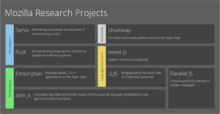Servo (software)
Servo is an experimental browser engine developed to take advantage of the memory safety properties and concurrency features of the Rust programming language. The project was initiated by Mozilla Research with effort from Samsung to port it to Android and ARM processors.[2] The prototype seeks to create a highly parallel environment, in which many components (such as rendering, layout, HTML parsing, image decoding, etc.) are handled by fine-grained, isolated tasks.
 | |
| Developer(s) | Mozilla Research, Samsung, and others |
|---|---|
| Repository | |
| Written in | Rust |
| Operating system | Cross-platform |
| Type | Browser engine |
| License | MPL 2.0[1] |
| Website | servo |
Two significant components used by Servo are based on existing C++ code from Mozilla. JavaScript support is provided by SpiderMonkey, and the 2D graphics library Azure is used to interface with OpenGL and Direct3D.[3]
Servo is named after Tom Servo, a robot from the television show Mystery Science Theater 3000.[4]
Features

As of 2015, development on Servo is still at an early stage; however, it can already render Wikipedia and GitHub, and successfully passes the Acid2 test. It features innovations like a parallel layout algorithm and its own CSS3 and HTML5 parser implemented in Rust.[5][6]
Servo makes use of GPU acceleration to render web pages more quickly and smoothly.[7][8] Servo is significantly faster, in certain benchmarks, than Gecko, Mozilla's other layout and rendering engine, as of November 2014.[9][10]
History

Development of Servo began in 2012. The first commit on 8 February 2012 did not contain any source code.[11] The first rudimentary code commit occurred on 27 March 2012.[12]
On 3 April 2013 Mozilla announced that they and Samsung are collaborating on Servo.[13][14]
As of 30 June 2016, a preview version has been available for download for macOS and Linux.[15]
Since then, builds have also been made available for Windows (starting on 13 April 2017),[16] Android (14 September 2018),[17] and the Magic Leap One augmented reality headset (3 December 2018).[18]
Servo project
Project goals
The Servo project itself is officially a research project. The goal is to create a new layout engine using a modern programming language (Rust), and using parallelism and code safety, to achieve greater security and performance versus contemporary browsers.
Relationship to Firefox
Servo developers have merged parts of Servo into Gecko, thus lending the Servo project's advancements to Firefox.[19][20]
Chromium Embedded Framework
Servo intended to re-implement the Chromium Embedded Framework (CEF) API. This would have allowed Servo to be used as a drop-in replacement for Chromium in applications using CEF, and would have positioned Servo as a competitor to Chromium in these cases.[21]
CEF support never reached a usable state and support was removed from Servo in early 2018.[22]
Project structure
The Servo project is sponsored and maintained by Mozilla, with several Mozilla employees contributing a majority of code to the project. As an open-source, free software project, it is open to contributions from anyone.[23] Servo, including all community contributions, is licensed under the Mozilla Public License version 2.0.
See also
References
- "servo/LICENSE". GitHub. Retrieved 5 December 2018.
- "Samsung teams up with Mozilla to build browser engine for multicore machines". Ars Technica. 3 April 2013. Retrieved 24 October 2014.
- Willis, Nathan (17 June 2015). "Parallel page rendering with Mozilla Servo". LWN.net. Retrieved 27 June 2015.
- Eich, Brendan (13 October 2012). "Add a new UI crate". Retrieved 2 April 2014.
- Moffitt, Jack (17 April 2014). "Another Big Milestone for Servo—Acid2". Retrieved 26 November 2015.
- "Servo Continues Pushing Forward". 1 May 2015. Retrieved 26 November 2015.
- Bergstrom, Lars. "Mozilla's Project Quantum and Servo". mozilla.dev.servo - Google Groups. Retrieved 9 November 2016.
- Clark, Lin (10 October 2017). "The whole web at maximum FPS: How WebRender gets rid of jank". Mozilla Hacks – the Web developer blog. Retrieved 22 October 2017.
- Larabel, Michael. "Mozilla's Servo Engine Is Crazy Fast Compared To Gecko". Phoronix. Retrieved 10 May 2016.
- "Mozilla's Servo Is Whooping The Other Browsers In Performance". Phoronix. Retrieved 10 May 2016.
- "initial add · servo/servo@ce30d45".
- "Add some stubs and a makefile · servo/servo@783455f".
- "Mozilla and Samsung Collaborate on Next Generation Web Browser Engine".
- "Mozilla, Samsung team up on 'Servo' next-gen browser engine".
- "Servo Nightly Builds Available". Servo Blog. 30 June 2016.
- "Windows nightly builds now available". Servo Blog. 13 April 2017.
- "Add Android download link". GitHub. Retrieved 8 December 2018.
- "A new browser for Magic Leap". 3 December 2018. Retrieved 20 May 2019.
- "Quantum - MozillaWiki". wiki.mozilla.org. Retrieved 28 October 2016.
- Bryant, David (27 October 2016). "A Quantum Leap for the Web – Mozilla Tech". Medium. Retrieved 28 October 2016.
- Blumenkrantz, Mike; Bergstrom, Lars (13 May 2015). "Servo: The Embeddable Browser Engine - Samsung Open Source Group Blog". Samsung Open Source Group Blog. Retrieved 28 October 2016.
- Dropping CEF support?, retrieved 7 November 2018
- Willis, Nathan (17 June 2015). "Parallel page rendering with Mozilla Servo". LWN.net. Retrieved 30 October 2016.
External links
| Wikimedia Commons has media related to Servo (layout engine). |